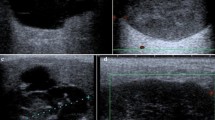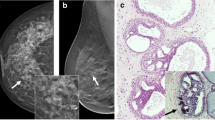Abstract
Solitary ductal papilloma of the breast, although considered a benign disorder has a potential association with carcinomas. We studied and analyzed the role of selective ductectomy (SD) for the diagnosis and treatment of intraductal lesions presenting with single duct discharge and ductography suggestive of intraductal (papillary) lesions. During a ten-year-period, files of patients presenting with single (or rarely dual) duct discharge were retrospectively reviewed. The examinations included mammography, ductography and ultrasonography and cytology of the fluid discharged from the duct in all patients. Patients treated with SD were considered further and their histological diagnosis and treatment were analyzed. The series included 100 patients. In 6 cases malignancy was found in the specimen consisting of four in situ and two invasive ductal carcinomas. These 6 patients had a second operation and this was followed by adjuvant treatment. Nine further patients had atypical ductal hyperplasia in or around papillomas and one patient had lobular neoplasia around her papilloma. In the present series, the incidence of carcinoma associated with the clinical suspicion of papillary lesions was 6%, and further 10% had low grade neoplastic proliferations resulting in the diagnosis of atypical papillomas or atypical ductal hyperplasia or lobular neoplasia around the papilloma, indicating that single duct discharge may be a symptom a malignancy, and that ductal papillomas have malignant potential. For such a low risk and grade of malignancy simple follow-up could be one option, but in some cases SD could be applied to relieve the patients from symptoms and establish a diagnosis.



Similar content being viewed by others
References
Greif F, Sharon E, Shechtman I, Morgenstern S, Gutman H (2010) Carcinoma within solitary ductal papilloma of the breast. EJSO 36:384–386
Maxwell AJ (2009) Ultrasound guided vacuum-assisted excision of breast papillomas: review of 6-years experience. Clin Radiol 64:801–806
Haagensen CD Diseases of the Breast 3rd ed (1986) Solitary intraductal papilloma. Philadelphia: WB Saunders, pp 137–175
Hou M-F, Huang T-J, Liu G-C (2005) The diagnostic value of galactography in patients with nipple discharge. Clin Imaging 25:74–81
Bruce L, Daniel R, Gardner W, Robyn L, Birdwell K, Nowels W, Denise J (2003) Magnetic resonance imaging of intraductal papilloma of the breast. Mag Reson Im 21:887–892
Hünerbein M, Dubowy A, Raubach M et al (2007) Gradient index ductoscopy and intraductal biopsy of intraductal breast lesions. Am J Surg 194:511–514
Leah S, Feldman SM, Balassanian R et al (2004) Association of breast cancer with papillary lesions identified at percutaneous image-guided breast biopsy. Am J Surg 188:365–370
Amendoeira I, Apostolikas N, Bellocq JP et al (2006) Quality assurance guidelines for pathology. In: Perry N, Broeders M, de Wolf C, Törnberg S, Holland R, von Karsa L (eds) European guidelines for quality assurance in breast cancer screening and diagnosis, 4th edn. European Comission, Luxemburg, pp 219–311
Cserni G (2012) Benign apocrine papillary lesions of the breast lacking or virtually lacking myoepihelial cells- potential pitfalls in diagnosing malignancy. APMIS 120:249–252
Gennari R, Galimberti V, De Cicco C et al (1999) Use of technetium-99m-labeled colloid albumin for preoperative and intraoperative localization of nonpalpable breast lesions. J Am Coll Surg 1(90):692–699
Leis HP Jr (1989) Management of nipple discharge. World J Surg 13:736–742
Buhl-Jorgensen SE, Fischermann K, Johansen H et al (1968) Cancer risk in intraductal papilloma and papillomatosis. Surg Gynecol Obstet 127:1307–1312
W Al Sarakbi, Worku D, Escobar PF, Mokbel K (2006) Breast papillomas: current managment with a focus on a new diagnostic and therapeutic modality. International Seminars in Surgical Oncology
Sneige N (2000) Fine-needle aspiration cytology of in situ epithelial cell proliferation in the breast. Am J Clin Pathol 113(5 Suppl 1):S38–S48
Kefah M, Pedro FE, Tadaharu M (2005) Mammary ductoscopy: current status and future prospects. EJSO 31:3–8
Shen K-W, Wu J, Lu J-S et al (2001) Fiberoptic ductoscopy for breast cancer patients with nipple discharge. Surg Endosc 15:1340–1345
Atkins H, Wolff B (1964) Discharge from the nipple. BJS 51:602–606
Urban JA (1963) Excision of the major duct system of the breast. Cancer 16:516–520
Dietz JR, Crowe JP, Grundfest S, Arrigan S, Kim JA (2002) Directed duct excision by using mammary ductoscopy in patients with pathologic nipple discharge. Surgery 132:582–587
Cardenosa G, Eklund GW (1991) Benign papillary neoplasms of the breast: mammographic findings. Radiology 181:751–755
Ali-Fehmi R, Carolin K, Wallis T, Visscher DW (2003) Clinicopathologic analysis of breast lesions associated with multiple papillomas. Hum Pathol 34:234–239
Page DL, Salhany KE, Jensen RA, Dupont WD (1996) Subsequent breast carcinoma risk after biopsy with atypia in a breast papilloma. Cancer 78:258–266
O’Malley F, Visscher D, MacGrogan G et al (2012) Intraductal papillary lesions. In: Lakhani SR, Ellis IO, Schnitt SJ et al (eds) WHO classification of tumours of the breast, 4th edn. International Agency for Research on Cancer, Lyon, pp 99–109
Cserni G (2011) The current TNM classification of breast carcinomas: controversial issues in eraly breast cancer. memo 4:144–148
Sakr R, Rouzier R, Salem C, Antoine M, Chopier J, Darai E et al (2008) Risk of breast cancer associated with papilloma. EJSO 34:1304–1308
El-Sayed ME, Rakha EA, Reed J, Lee AHS, Evans AJ, Ellis IO (2008) Predictive value of needle core biopsy diagnoses of lesions of uncertain malignant potential (B+) in abnormalities detected by mammographic screening. Hystopathology 53:650–657
Conflict of interest statement
None declared.
Author information
Authors and Affiliations
Corresponding author
Rights and permissions
About this article
Cite this article
Maráz, R., Boross, G., Ambrózay, É. et al. Selective Ductectomy for the Diagnosis and Treatment of Intraductal Papillary Lesions Presenting with Single Duct Discharge. Pathol. Oncol. Res. 19, 589–595 (2013). https://doi.org/10.1007/s12253-013-9622-4
Received:
Accepted:
Published:
Issue Date:
DOI: https://doi.org/10.1007/s12253-013-9622-4




